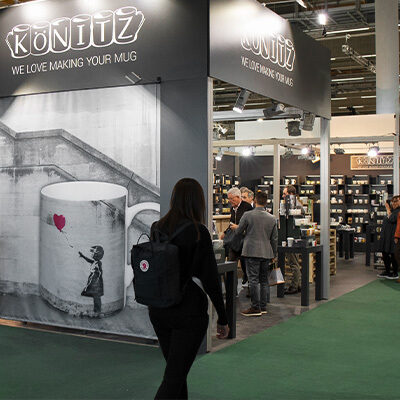The Artist
- Who? Raffaello Sanzio da Urbino
- Born: April 6 or March 28, 1483 in Urbino (died: April 6, 1520 in Rome)
- Style: Italian Renaissance
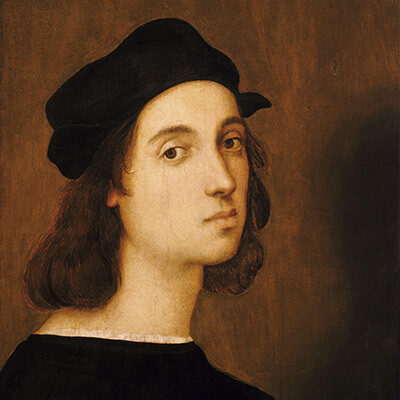
Raffaello Sanzio da Urbino, also known as Raphael da Urbino, Raffaello Santi, Raffaello Sanzio or Raphael for short, was an Italian painter and architect. He is considered one of the most important artists of the Italian High Renaissance.
Raphael gained fame primarily as a painter through his harmonious and lovely Madonna paintings. Until well into the 19th century, he was considered the greatest painter of all time. In addition to his career as a painter, he also became the director of construction of St. Peter's Basilica and overseer of Roman antiquities. It is believed that Raphael was born on March 28, 1483 or April 6, 1483, this assumption goes back to them 1550 published artist biographies or Vite Giorgio Vasaris, who wrote that Raphael died on Good Friday, April 6, 1520, "on the day he was born": Because of this wording, it is disputed whether Vasari meant Good Friday, which in 1483 fell on March 28, or April 6. In general, many of Vasari's statements are inaccurate and therefore disputed by modern scholars. Raphael's birthday is therefore not considered certain.
Raphael's father died in 1494 and is said to have given the young one his first training in painting. Around 1500, possibly as early as 1494, the young Raphael went to Perugia, in Italy, and entered as a student in the workshop of Pietro Vanucci also called Perugino. There Raphael managed to approach Perugino's style to such an extent that it was difficult to distinguish between their works. Raphael's painting skills were already so pronounced at a young age that in 1500, at the age of 17, he was named magister (master) in the oldest of his surviving contracts, an agreement for an altarpiece in Cittá i Castello.
Around 1502/03 Raphael completed his first major independent painting, the London Crucifixion, and around the same time the artist painted for the church of San Francesco in Perguia, The Coronation of Mary (now Rome). Both compositions are closely based on paintings by Raphael's teacher Perugino.
In 1504 Raphael completed his masterpiece, The Marriage of Mary, for the church of San Francesco in Cittá di Castello. With this painting he surpassed his teacher Perugino, who also painted a Marriage of Mary at the same time.
That same year, with a letter of recommendation from the Urbino court, Raphael went to Florence, where Michelangelo and Leonardo da Vinci had already achieved fame. Their masterpieces exerted a significant influence on Raphael's further artistic development. There the painter received numerous commissions from Florentines, and his Madonna paintings were especially highly regarded. In 1505 he returned to Perugia.
Since he was unable to perfect his painting in Perugia as he had envisioned, Raphael moved to Florence for a second time in 1506 to continue his study of the older masters. Here he painted more Madonna paintings, such as the Vienna Madonna in the Green (1506) but also some portraits.
From 1508 he stayed in Rome. However, Raphael's main commission in Rome was to decorate the papal apartments (stanzas) in the Apostolic Palace with monumental wall paintings.
In 1512 - 1513 Raphael created his most famous Madonna painting, the Sistine Madonna for the high altar of the monastery church of San Sisto in Piacenza.
After Bramante's death, Raphael succeeded him in 1514 and was appointed architect and building supervisor of the new St. Peter's Church.
His last masterpiece, painted largely by his own hand, was the Transfiguration of Christ..
Raphael died on April 6, 1520, at the age of 37, possibly from bloodletting to cure a venereal disease he is said to have contracted during his numerous affairs with women. According to other sources, he died of malaria after an archaeological sojourn in swampy areas around Rome. A dramatic cause of death such as the plague is also considered by historians, because the usual funeral rituals of the time were greatly abbreviated in order to bury Raphael's body as quickly as possible in Rome: Possibly this was to prevent contagion.
The Artwork
- Name: Madonna Sistina
- Created around: 1512 - 1513
- Technique: Oil on canvas
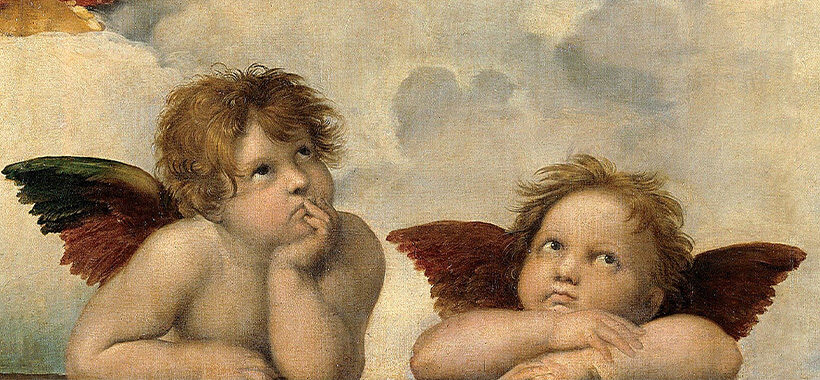
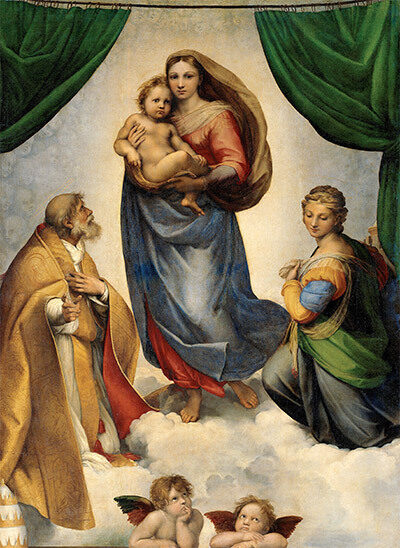
The Madonna Sistina by Raffaello Sanzio (Raphael) is one of the most famous paintings of the Italian Renaissance. The painting was created in 1512 -1513 by Raphael for the high altar of the monastery church of San Sisto in Piacenza. It is a work commissioned by Pope Julius II, celebrating the Pope's victory over the French who invaded Italy, and was donated on the occasion of the incorporation of the city of Piacenza into the Papal States (1512).
The painting depicts, among others, St. Sixtus, to whom the monastery was dedicated and after whom Raphael's portrait of the Madonna is ultimately named. The three figures are arranged in a triangle, folded back curtains in the upper corners of the picture emphasize the geometric composition. St. Sixtus, at whose feet the tiara stands as an insignia, points out of the picture toward the crucifix. The Madonna and the child look seriously in the direction indicated, while St. Barbara on the right humbly lowers her gaze. In its original place, the image was placed on the back wall of the altar opposite a large crucifix. The body language of the figures and especially the facial expression of the infant Jesus, like that of his mother, seem to express a foreshadowing of Christ's death on the cross. In the background you think you see clouds, but if you look closely you can see the faces of countless angels.
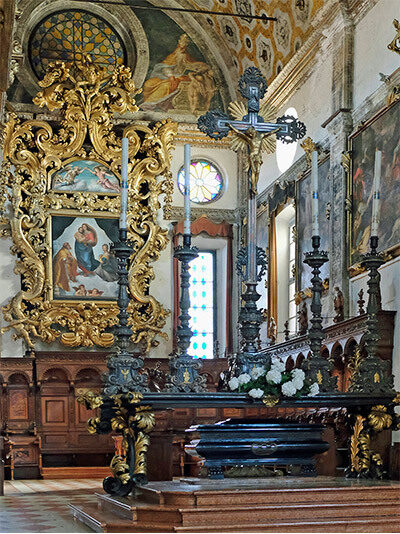
https://de.wikipedia.org/wiki/Raffael
https://de.wikipedia.org/wiki/Sixtinische_Madonna
https://www.google.com/searchgs_ssp=eJzj4tDP1TdINjFON2D0kipKTEtLTM3JyVcoTsyrysxXSElUKC1KyszLBwDlXQzI&q=raffaello+sanzio+da+urbino&oq=Raffael+Sanzio+&aqs=chrome.1.69i57j46i10i512j0i10i512l7.8897j0j15&sourceid=chrome&ie=UTF-8
